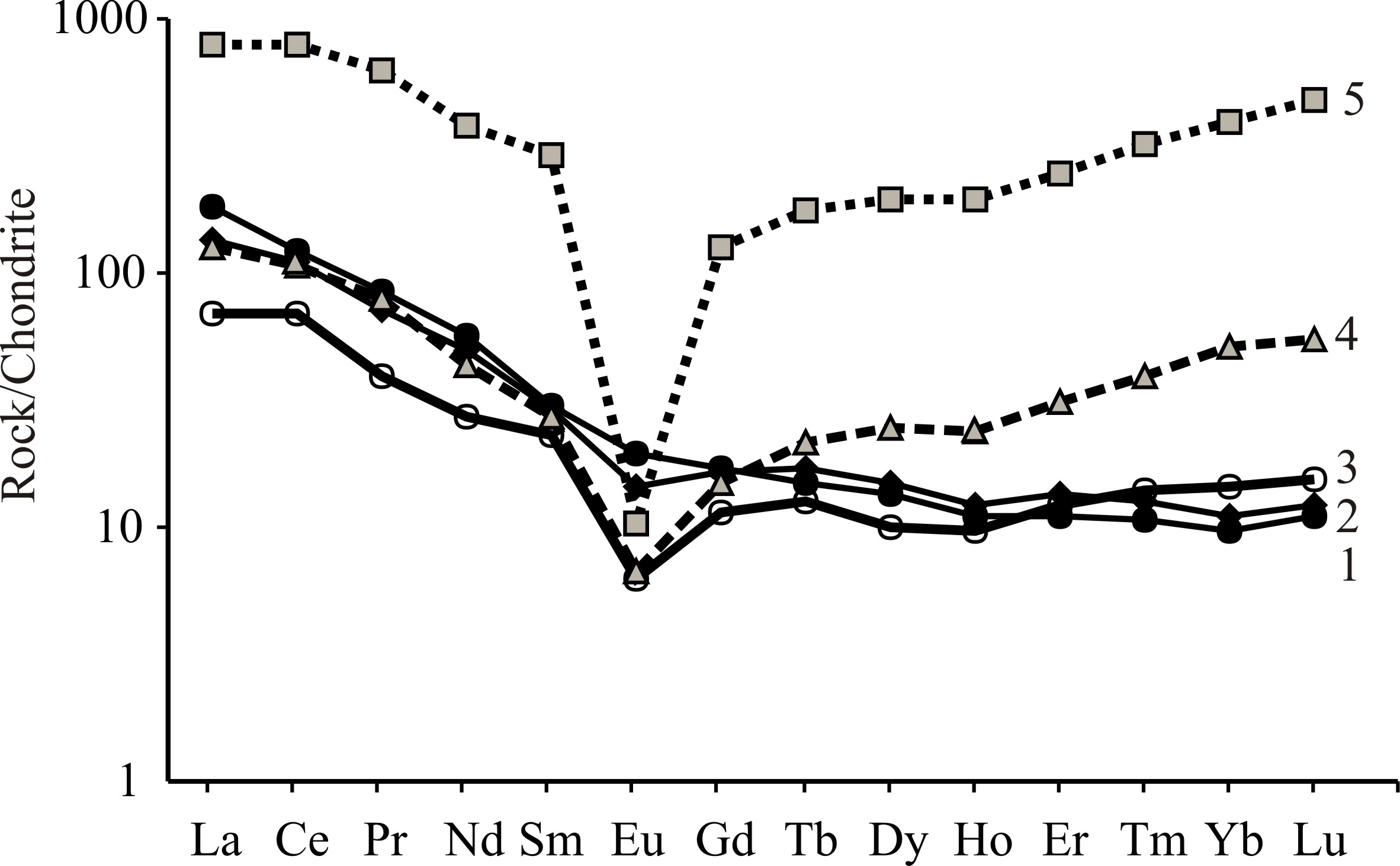|
RARE METAL MINERALIZATION IN EARLY PROTEROZOIC POSTCOLISIONAL GRANITES OF THE PRIMORSKIY COMPLEX (WEST PREBAIKALIA) Institute of the Earth's Crust SB RAS, Irkutsk, Russia, vsavel@crust.irk.ru
Postcollisional granitoids of the Primorskiy Complex of age 1859 ± 16 Ma (Donskaya et al. 2003) that are referred to formation of rapakivi-granites are represented by large bodies localized in zone of the Primorskiy deep fault. Within the complex, coarse- and irregular-grained, often porphyry-like, amphibole-biotite and biotite granites of the first phase, and middle- and fine-grained biotite and leucocratic granites of the second phase are distinguished. The rare metal and rare earth mineralization in granites of the Primorskiy Complex have been initially found during geological surveys (Ryabykh, Ryabykh 1974). The rare metal mineralization is associated with albitized and greisenized mid- and fine—grained granites and quartz veins with higher concentrations of Sn, Bi, Nb, etc. The authors have studied an occurrence of rare metal mineralization in the Upper Ulan-Khan river. Here, coarse-grained porphyry-like granites and rocks of the Iliktinskaya suite PR1 are cut by mid- and fine-grained leucocratic biotite and muscovite granites, often with granophyric structure. In some areas, the fine-grained granites are albitized, tourmalinized, greisenized and often contain fluorite. Porphyry-like and fine-grained granites are in fact not differed by chemical composition. These are subalkaline leucogranites, with significant predominance of K over Na (Na2O/K2O = 0.44-0.55) that are saturated or oversaturated by alumina (ASI = 0.93-1.18) with low CaO (0.10—0.85%). Fine-grained granites are differed from coarse-grained ones by lower contents of MgO (0.04-0.13%), higher FeO*/MgO (21-30) and sharper negative Eu anomaly (Eu/Eu* = 0.30-0.39) (Fig.1).
Fig. 1. REE distribution in rocks of the Primorskiy Complex. Granites: 1, 2 – porphyry-like, 3 – fine-grained, 4 – albitized, 5 – quartz-muscovite greisen Rock/chondrite
Fine-grained granites are characterized by higher than clark contents of Rb (to 250 ppm) for low Ca granites, Ba (1000-1400 ppm), Th (23-32 ppm), Sn (5-22 ppm), Zr (300-340 ppm), near clark contents of Be, Y, Nb. The content of F is 200-400 ppm. Contents of Na2O are 3.9-4.8% and Na2O/K2O ratios are near 1 in the albitized granites. F content reaches 7000-15000 ppm in albitized granites and quartz-muscovite greisens. Contents of Rb increase up to 600-1100 ppm, Li – 85-200 ppm, Sn – 230-310 ppm, Y – 210 ppm, Nb – 190 ppm, Th – 200, U – 140, Ta – 25, Hf – 36 ppm .In addition, the contents of heavy rare earth elements increase in albitized granites, and both light and heavy rare earth elements – in quartz-muscovite greisens (total content of lanthanoids reaches 1800 ppm) (Fig.1). The following rare metal and rare earth minerals have been revealed in albitized and greisenized granites by use of scanning electron microscope LEO-1430VP with energy dispersive analyzer INCAEnergy-300 (Geological Institute SB RAS, analyst N.S. Karmanov): cassiterite, columbite, mineral of pechekite group (?), polycrase – (Y), yttrocrasite – (Y), rutile, fluocerite – (Ce), bastnesite – (Ce), thorite. The usual accessory minerals of granites are also zircon, allanite – (Ce), epidote, sphene, garnet, magnetite, ilmenite. Cassiterite (SnO2) is particularly specific of quartz-muscovite greisens and tourmalinized albitized granites, where it is represented by grains up to 0.3 mm in size. Admixtures are not revealed in the mineral. Columbite (Fe, Mn)(Nb, Ta)2O6 is represented by grains to 0.2 mm, they are often hydrothermally altered. It contains 67-70% Nb2O5, 5.9-7.9% Ta2O5, 14.3-18.4 FeO, up to 4% MnOand also WO3 (1.9-3.4) and TiO2 (1.1-3.8%). At colombite hydrothermal alteration, total oxides sharply decrease due to the decreasing contents of Nb2O5 (to 23%) and FeO (to 2 %0 at stable content of Ta2O5 and increasing contents of TiO2 (to 16 %), UO3 (to 25%\ and PbO (to 12 %). The pechekite group mineral FeU (Nb, Ta)2O8 presumably forms fine inclusions in columbite. It contains 23-32% Nb2O5, 27-29% Ta2O5, 12-14% UO3, 9-14.5% PbO, 5.2-6.2% WO3, 5-6% TiO2 and also admixtures FeO, Y2O3, ThO2. Polycrase – (Y) Y(Ti, Nb)2O6 is represented by small grains (0.1-0.2 mm). It contains 28-30% TiO2, 12.5-13.9% Nb2O5, 13.6-18.1% TR(Y)2O3, 12.8-14%UO2 and admixtures Th, W (to 2.6% WO3), Al, Fe, Cs. Yttrocrasite – (Y) (Y,Th)Ti2(O,OH)6 forms fine inclusions in the ore-forming minerals. It contains 45-49.7% TiO2, 32-41.6% TR(Y)2O3, 3.7-4.2% Nb2O5, to 3% WO3, 2.2-7% ThO2, to 2% UO2. Rutile (TiO2) contains admixtures of Nb2O5 (5.4-8.8%), SnO (1.3%) and FeO (2.2-4.2%). Sphene (CaTiSiO5) is characterized by high contents of Al2O3 (5.7-9.4%), F (2.1-5.1%) and contains admixtures of Nb2O5 (1.0-1.7%), Y2O3 (to 5%). Fluorite - (Ce) CeF3 is represented by parts of mm grains in size. It contains 70%TR and 29.4-30.1% F. Composition of lantanoids when recalculated for 100%: Ce57La21Nd16Pr4Sm2. Bastnesite – (Ce) CeCO3F is a secondary mineral that replaces columbite and fluocerite. Total content of TR2O3 is 64-67%. Composition of lanthanoids varies (in recalculation for 100%: Ce46-58Nd18-32La9-18Pr5-8Sm2-6). Allanite – (Ce) Ce2Fe2AlO(OH)[SiO4][Si2O7] is represented by individual grains, intergrowths with biotite, sphene and is enveloped by epidote. Total TR2O3 = 19.8-26.6%; composition of lanthanoids in recalculation for 100%: Ce46-58La23-33Nd11-29Pr0-5. Epidote sometimes contains up to 1.6% Y2O3. Thorite (ThSiO4) is represented by grains up to 0.3 mm in size that are often hydrothermally altered (thorogummites), and it also forms fine inclusions in other minerals. SiO2 makes up 14.2% and ThO2 – 75.1% in unaltered thorite. Admixtures of TR(Y)2O3 = 2-8%, Nb2O5 – up to 2%, P2O5 – to 4%, F – 3-5.7% and FeO – to 3.5%. The work has been carried out with financial support of Russian Foundation for Basic Research, grant N06-05-64203. References Donskaya T.V., Bibikova E.V., Mazukabzov A.M. et al. (2003) The Primorskiy Complex of West Prebaikalian granitoids: geochronology, geodynamic typization // Geology and Geophysics, N10, P.1006-1016. Ryabykh A.M., Ryabykh E.M. (1974) About rare metal mineralization in granites of the Primorskiy Complex (West Prebaikalia) // Endogenic deposits of the Sayan-Baikal mountain area. Irkutsk, East-Siberian Publ. House, P.86-89.
|
